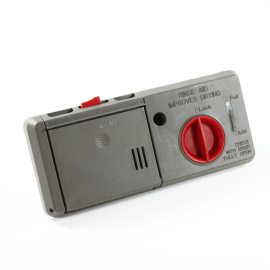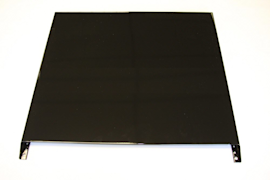
Frigidaire PureSource Plus Refrigerator Water F...
Part #WFCB
Get free shipping with Automatic Reorder


If your dishes always come out of the dishwasher a little less than clean, you might be tempted to rinse them before loading. But that’s old school and completely unnecessary with modern dishwashers. If your dishes are dirty, the problem could be that you're overloading the dishwasher or loading it incorrectly.
The key is to allow room for water to flow around the dishes and to not block the streams of water coming from the dishwasher’s spray arms. In this video, we show you how to load dishes so they get clean and aren’t damaged. And we’ll tell you what dishes you should never wash in a dishwasher and why.
For additional dishwasher troubleshooting advice, step-by-step repair guides and error code charts, check out our Dishwasher DIY Repair page.
When loading your dishwasher, make sure the dirtiest part of the dish faces down so it gets direct spray from the spray arms. Place dishes with concave surfaces—like the bottoms of coffee mugs—at an angle on the dishrack to allow water to drain easier and improve drying. Always check that all spray arms spin freely before you start the dishwasher cycle.
Remove labels from jars and bottles before loading in the dishwasher, or hand wash these items because the labels can fall off during washing, clogging the screens and pumps inside the dishwasher.
Now, let's talk about loading the different dishracks. The top rack is best suited for cups, glasses and lightweight plastic items. Place cups and glasses in the rows between tines—not over them, which can cause glasses to break. Put all your plastic dishes and storage containers on the upper rack—some plastics can melt if they’re too close to the heating element at the bottom of the dishwasher tub. Wedge the lids of storage containers between the tines and a glass to prevent the lids from coming loose and falling to the bottom of the tub.
Or, use no-flip clips to hold lids or larger plastic items such as cups, bowls or storage containers, in place during washing. These clips fit the tines on most dishwasher model, regardless of brand. Order plenty of clips and use them to keep all your plastic items in place.
Larger cooking utensils also should go on the upper rack, with spoons facing down so they don’t collect water.
The bottom dishrack is best for plates, pots, pans and casserole dishes. Glasses and mugs that don’t fit in the top rack also should go here. Load plates with the dirty side facing the center, with enough room between each plate to let water reach both sides. Angle pots, pans and casserole dishes with the dirty surface facing down. If your dishwasher is a Kenmore with TurboZone spray jets, face heavily soiled dishes toward the TurboZone jets and select the TurboZone option for the cycle.
You can load bowls in either rack, but you usually need to load larger mixing or serving bowls in the bottom rack if they're too big for the top rack. Load taller items like cookie sheets on the outer edges of the bottom rack, making sure not to block the soap dispenser. If a cookie sheet or other item is too tall, see if you can raise the upper rack using the buttons or knobs on the side of the rack. If all else fails, you can release the rail clips and pull the upper dishrack completely out to wash multiple tall items in the lower dishrack.
The silverware basket often fits in or on the bottom dishrack but it may reside in the top rack on some models.
Use the slots in the covers to keep your silverware separated for best cleaning. Load knives and sharp utensils such as skewers into the slots facing down and all other items facing up.
If your silverware doesn't fit into the slots, flip the covers up and mix silverware types to keep them separated. Alternate the direction of spoon handles up and down so that spoons don't nest together with other spoons—the same goes for forks.
Load all knives and sharp objects with the blades and points facing down.
There also are items you shouldn't wash in your dishwasher.
Disposable aluminum tops this list. Disposable aluminum rusts, leaving black residue on the item you're washing and possibly the surrounding items. Instead, hand wash disposable aluminum pie plates and serving the.
Anodized aluminum and cast iron cookware don't fare well in the dishwasher because dishwasher detergent erodes the seasoned coatings on these items.
Dishwashers can harm certain china or stoneware not marked dishwasher-safe. Check the label before placing decorative dishes in the dishwasher. Leaded crystal can etch quickly when you wash it in the dishwasher.
Certain flatware shouldn’t go in the dishwasher either. If you want to keep that nice shiny finish on your gold flatware, wash it by hand to avoid permanent damage from dishwasher detergent. Knives that use adhesive to attach the handle to the blade also shouldn't go into the dishwasher. The detergent and high water temperatures can erode the glue, causing the handle to eventually fall off. Many people who have high-quality knives prefer to wash them by hand, so the blade doesn’t get dull by bumping into other utensils.
It’s best to wash pewter, brass, bronze, copper and tin items by hand because dishwasher detergent can oxidize or permanently change the color of their finishes. Check the label on all unusual items that you're thinking about washing in the dishwasher to make sure they're dishwasher safe.
Finally, don’t put wooden cookware or utensils in the dishwasher because high heat, water and steam can cause wood to warp and split.
Follow these loading tips to help your dishwasher get your dishes as clean as possible and keep them damage-free. Check out our Sears PartsDirect YouTube channel for more appliance advice and repair help videos. Subscribe and we’ll send you updates when we post new videos.
Choose a symptom to see related dishwasher repairs.
Main causes: broken door spring, damaged or broken door hinge…
Main causes: not using rinse aid, rinse aid dispenser failure, broken heating element, malfunctioning vent, drying fan f…
Main causes: water supply problem, stuck overfill float, clogged water inlet valve screen, water inlet valve failure…
Main causes: light switch beside the sink turned off, lack of power, bad dishwasher door switch, control system failure,…
Main causes: improper loading, low water temperature, improper detergent dosage, detergent dispenser failure, spray arm …
Main causes: glass or popcorn kernel stuck in the chopper blade, drain line vibrating against the cabinet, debris in was…
Main causes: clogged kitchen sink drain, clogged drain hose, drain check valve damaged, drain pump failure, control syst…
Main cause: damaged rack height adjuster…
Main causes: damaged or stuck spray arm, leaking door seal, damaged door hinge, leaky heating element water seal, cracke…
These step-by-step repair guides will help you safely fix what’s broken on your dishwasher.

If your dishwasher fills constantly or won't fill at all, the water inlet valve has failed. You can replace it in about …

Dishes need dish detergent to get clean. Learn how to replace a dishwasher detergent dispenser with easy step-by-step i…

If your dishwasher door is dented or you want it to match your cabinets or other appliances, this guide shows how to rep…
Use the advice and tips in these articles and videos to get the most out of your dishwasher.

Get tips on completing essential holiday cleaning tasks to brighten your home.…

Learn about all the convenient features on our Sears PartsDirect website that make your parts purchases easier.…

Get answers to frequently asked questions about Sears and Sears PartsDirect.…